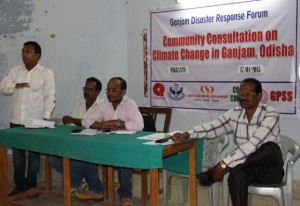 Ganjam traditionally sends half a million migrant labourers to Surat and Ahmedabad every year. Climate change has become a major concern for the communities in Ganjam. Frequent natural disaster like cyclone, flood, heavy rain, drought and famine has broken the backbone of the people dependent on livelihood in Ganjam. Individuals and communities in the Ganjam incorporate environmental risk into their livelihoods. Their ability to do so effectively is contingent upon their available assets. The prolonged drought situations are believed to be key reason for pushing migration of poor landless agriculture labourers and small farmers to other states. The last phailin in October 2013 affected 22 blocks of Ganjam. An astounding 15.02 lakh people have been impacted with death figures put at 10 in the district. A total of 2,16,100 ha of crop area and 2,30,000 homes have been affected, according to state government sources. It has also affected the fisher man and coastal communities with the damage of boats, fishing nets and other implements of marine fishermen have been destroyed and washed into the sea.
Ganjam traditionally sends half a million migrant labourers to Surat and Ahmedabad every year. Climate change has become a major concern for the communities in Ganjam. Frequent natural disaster like cyclone, flood, heavy rain, drought and famine has broken the backbone of the people dependent on livelihood in Ganjam. Individuals and communities in the Ganjam incorporate environmental risk into their livelihoods. Their ability to do so effectively is contingent upon their available assets. The prolonged drought situations are believed to be key reason for pushing migration of poor landless agriculture labourers and small farmers to other states. The last phailin in October 2013 affected 22 blocks of Ganjam. An astounding 15.02 lakh people have been impacted with death figures put at 10 in the district. A total of 2,16,100 ha of crop area and 2,30,000 homes have been affected, according to state government sources. It has also affected the fisher man and coastal communities with the damage of boats, fishing nets and other implements of marine fishermen have been destroyed and washed into the sea.
The characteristics of distress migration in Ganjam are quite different as they are shaped by the severity and geography of a crisis, the ability of a household to respond, evacuation opportunities, existing and perpetuating vulnerabilities, available relief, and intervening government policies. This distress migration due to climate change has been affected their living condition, health (spacifically HIV in Ganjam), education of children, social life and the rural economy. The policies of government for the migrant worker has been flawed which disallow identification of migrants (registration), safe and healthy living vicinity in workplace and living place of migrants, social security like labour insurance are among the major. Most importantly the District Disaster Management Plan of Ganjam did not consider the issue of migration.
This basic objective of the community consultation to draw the affects of climate change to various communities like coastal, fisherman, tribals, migrants, agriculture labourers, farmers and people in general and to prepare a long term strategy to overcome the affect and influence government for efficient policy to reduce the risk of frequent disaster and climate change. GDRF has been planned to prepare ‘climate change mitigation and risk reduction strategy’ in Ganjam and this is the first step towards the long journey.
Among the suggestions to mitigate the distress migration and provide better living space in workplace are expansion of livelihood options of the communities, climate change adaptation practices and opportunities, insurance and social security to the migrants, effective implementation of the Inter-state migrant workmen (regulation of employment and condition of services) act 1997 and un organised workers social security bill, 2008 and make provision for better employment opportunities for the skilled labour force in Ganjam , Odisha. And on the other hand efficient implementation of policies and a long term strategy for disaster mitigation and risk reduction are major areas of suggestions from the civil society network.
Today’s consultation prioritised the issues of ‘migrant workers’ of various blocks in Ganjam district. More than 50 migrants from Ganjam district have been assembled to share their concern and issues of distress migration and its impact on migration. GDRF has been formed as a civil society network of local NGOs initiated by ARUNA, UAA, YSD, Coast Council, GPSS and ISARA. Mr. Lokanath Misra of ARUNA hand convenor of GDRF presided over the meeting and Mr. Sudarshan Chhotaray of Coast Council facilitated the consultation. Mr. Mangaraj Panda of UAA, Mr. Brundaban Panda of GPSS, Mr. Rabindra Nath Patro of ISARA and Mr. Bibhu Prasad Sahu of YSD supported the event.
